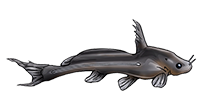1. Water parameters
a) 74-75F
b) 6.8 pH.
c) 2 GH.
d) 2 KH
e) 0 Ammonia, 10 Nitrate, 0 Nitrite
f) 30% weekly
29 gallons, soft, fine playsand, 200 gph canister with sponge prefilter, planted, ~15 habrosus ~ 10 pygmaeus, ~15 crystal red shrimp, couple of < 1" bristlenose fry, setup for ~ 6 mths. They are fed a variety of NLS/Hikari flake, pellet, frozen and fresh veggies, very occasionally live black worms.
All fish appear fine and happy, both species are occasionally laying eggs recently. But over the last 3 months I have lost around 20 fish, habrosus and pygmaeus both. One appears to get extremely skinny, wastes away and dies.
Medications used (if any):
Levamisole
Prazipro
Melafix/Pimafix combo
each medication had a period of at least 2 weeks and 3 large water changes between.
I'm at a loss.
Wasting Habrosus & Pygmaeus
- apistomaster
- Posts: 4735
- Joined: 10 Jun 2006, 14:26
- I've donated: $90.00!
- My articles: 1
- My cats species list: 12 (i:0, k:0)
- My Wishlist: 1
- Location 1: Clarkston, WA, USA
- Location 2: Clarkston, WA, USA
- Interests: Aquaculture and flyfishing
Re: Wasting Habrosus & Pygmaeus
I feed my Dwarf Corydoras newly hatched brine shrimp every day. I recently stopped raising C. habrosus and am now only continuing to breed Corydoras hastatus. I use much warmer water. 80 to 84*F. I also use soft water for C. hastatus breeding. In fact for both species I use breeding colonies that are permanent set ups. I allowed my C. hastatus colony to crash after I removed them from their breeding tank until I was down to 50 from 200. I am now very close to getting back to 200. At that number I can afford to harvest over 150 a year and yet maintain nearly a constant population of 200 in a 20 long which has an air stone, a larger sponge filter running off it's air lift and one run by a MaxiJet 600 power head(600 lph/160 gph) in a 20 gal long. I use Azoo OxygenPlus Bio-Filter #6 sponge filters. An equivalent is the HydroSponge IV. That 200 includes all sizes from newly hatched fry to breeding adults. The breeding size fish population is about 100. As I sell off young adults they are quickly replaced by up and coming fry.
I growth a thick mat of Hornwort and provide a large rubble pile of hollow ceramic media pieces for the larvae and fry to hide until they are ready to join to older fish in the tank which happens when they reach about 1/4 inch long.
I also keep a colony of Cherry Shrimp in these permanent breeding colony set ups.
I think increasing the live food will do the most good. I do not think you have a disease problem and have no need to be treating them. FWIW, My experience with levimazole is that it is more toxic than flubendazole and praziquantel and the drug seems to have adverse side effects on the central nervous system and is very stressful for the treated fish. I would need a specific and compelling reason to use it. In general, I do not advise using it.
I keep the water at 40 to 60 ppm TDS and the pH drops to about 6.2 to 6.6. I use a mix of 80% RO water and 20% tap water.
I think your water is too cool although C. habrosus do prefer 80*F where C. hastatus seem to do well at 84*F.
This is not quite "by the book." It is however the method I have used for over 5 years and I began with only 10 wild C. hastatus.
I growth a thick mat of Hornwort and provide a large rubble pile of hollow ceramic media pieces for the larvae and fry to hide until they are ready to join to older fish in the tank which happens when they reach about 1/4 inch long.
I also keep a colony of Cherry Shrimp in these permanent breeding colony set ups.
I think increasing the live food will do the most good. I do not think you have a disease problem and have no need to be treating them. FWIW, My experience with levimazole is that it is more toxic than flubendazole and praziquantel and the drug seems to have adverse side effects on the central nervous system and is very stressful for the treated fish. I would need a specific and compelling reason to use it. In general, I do not advise using it.
I keep the water at 40 to 60 ppm TDS and the pH drops to about 6.2 to 6.6. I use a mix of 80% RO water and 20% tap water.
I think your water is too cool although C. habrosus do prefer 80*F where C. hastatus seem to do well at 84*F.
This is not quite "by the book." It is however the method I have used for over 5 years and I began with only 10 wild C. hastatus.
Avid Trout fly fisherman. ·´¯`·...¸><)))º>




